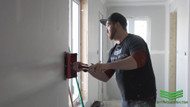Drywall Flat Box Mud Consistency Guide
Author: Lucas H
Publish Date: February 25, 2021
Read on for a complete guide to drywall flat box joint compound consistency. You can also check out the video below for a full in-depth overview courtesy of Drywall Nation.
Using the right type of mud is the first step to success when it comes to drywall taping tools. Flat boxes are a completely different setup than your automatic taper. When you're applying tape with an automatic taper, you want to make sure that you're using taping mud because it needs that glue to bond the tape to the wall. When you're using a drywall flat box, you definitely want to use an all-purpose or lightweight mud because you don't want that same level of "stickiness" you get in automatic taper mud. If your mud is too sticky when using your finishing box, you're going to get pinholes or bubbles showing up once the mud has been applied to the wall.
.jpg)
WHAT KIND OF DRYWALL JOINT COMPOUND DO I NEED?
An all-purpose or lightweight mud is what is recommended when you're running a drywall flat box. In terms of joint compound consistency, there are pros and cons to both. If you're using thin mud you can see it's a lot runnier than thicker mud. It doesn't run as much so with thin mud you'll notice it's a lot easier on the body to physically push.
However, with thin mud you're more likely to get drag marks at the start of a run. This is because the mud is so thin, it's easy to push out of the box too fast. As you're applying pressure to the box on the ceiling or against a wall, the mud rolls over on the back of the travel bar and then as you lift off the wall you get something that kind of looks like a Christmas tree.
If your line is dragging down the wall for the first few inches and you're getting a lot of "Christmas trees" or a lot of drag, that's because your mud is too thin and watered down. This would cause it to shrink back a lot more as it dries. That's one of the pros of thick mud - if your mud is thicker there's less moisture, there's less humidity in the air and there's going to be less shrinking because there's less water. Thicker mud is a little harder to push; there's more resistance on your body and more resistance against the travel bar. With thick mud, however, you're less likely to get those drag marks.
At the start of a run, you're going to get much less shrinking, so it really comes down to personal preference. There's no right or wrong way when it comes to your joint compound consistency - it's what works best for you and yields the best results on your specific job site.

Have questions? Give us a call at 800.227.7713 or send us an email at info@level5tools.com.
Read on for a complete guide to drywall flat box joint compound consistency. You can also check out the video below for a full in-depth overview courtesy of Drywall Nation.
Using the right type of mud is the first step to success when it comes to drywall taping tools. Flat boxes are a completely different setup than your automatic taper. When you're applying tape with an automatic taper, you want to make sure that you're using taping mud because it needs that glue to bond the tape to the wall. When you're using a drywall flat box, you definitely want to use an all-purpose or lightweight mud because you don't want that same level of "stickiness" you get in automatic taper mud. If your mud is too sticky when using your finishing box, you're going to get pinholes or bubbles showing up once the mud has been applied to the wall.
.jpg)
WHAT KIND OF DRYWALL JOINT COMPOUND DO I NEED?
An all-purpose or lightweight mud is what is recommended when you're running a drywall flat box. In terms of joint compound consistency, there are pros and cons to both. If you're using thin mud you can see it's a lot runnier than thicker mud. It doesn't run as much so with thin mud you'll notice it's a lot easier on the body to physically push.
However, with thin mud you're more likely to get drag marks at the start of a run. This is because the mud is so thin, it's easy to push out of the box too fast. As you're applying pressure to the box on the ceiling or against a wall, the mud rolls over on the back of the travel bar and then as you lift off the wall you get something that kind of looks like a Christmas tree.
If your line is dragging down the wall for the first few inches and you're getting a lot of "Christmas trees" or a lot of drag, that's because your mud is too thin and watered down. This would cause it to shrink back a lot more as it dries. That's one of the pros of thick mud - if your mud is thicker there's less moisture, there's less humidity in the air and there's going to be less shrinking because there's less water. Thicker mud is a little harder to push; there's more resistance on your body and more resistance against the travel bar. With thick mud, however, you're less likely to get those drag marks.
At the start of a run, you're going to get much less shrinking, so it really comes down to personal preference. There's no right or wrong way when it comes to your joint compound consistency - it's what works best for you and yields the best results on your specific job site.

Have questions? Give us a call at 800.227.7713 or send us an email at info@level5tools.com.





